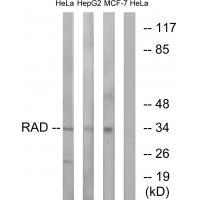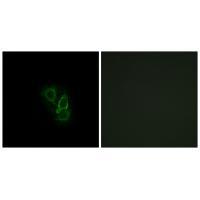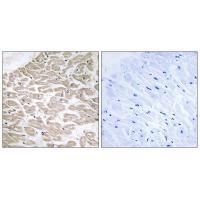


| WB | 咨询技术 | Human,Mouse,Rat |
| IF | 咨询技术 | Human,Mouse,Rat |
| IHC | 1/50-1/100 | Human,Mouse,Rat |
| ICC | 1/100-1/500 | Human,Mouse,Rat |
| FCM | 咨询技术 | Human,Mouse,Rat |
| Elisa | 咨询技术 | Human,Mouse,Rat |
| Aliases | GTP-binding protein RAD; RAD; RAD1; RAS associated with diabetes; |
| Entrez GeneID | 6236; |
| WB Predicted band size | 33kDa |
| Host/Isotype | Rabbit IgG |
| Antibody Type | Primary antibody |
| Storage | Store at 4°C short term. Aliquot and store at -20°C long term. Avoid freeze/thaw cycles. |
| Species Reactivity | Human,Mouse,Rat |
| Immunogen | Synthesized peptide derived from internal of human RAD. |
| Formulation | Purified antibody in PBS with 0.05% sodium azide. |
+ +
以下是3篇与RAD抗体相关的研究文献摘要概括,供参考:
---
1. **文献名称**: *RAD51 as a functional biomarker for homologous recombination repair deficiency in cancer*
**作者**: Gogola et al. (2018)
**摘要**: 研究验证了RAD51抗体的临床应用,证明通过免疫荧光检测RAD51蛋白聚集可评估肿瘤细胞同源重组修复缺陷(HRD),对预测PARP抑制剂治疗响应具有临床价值。
2. **文献名称**: *Structural insights into RAD52-mediated DNA repair mechanisms*
**作者**: Saotome et al. (2020)
**摘要**: 利用冷冻电镜和RAD52特异性抗体,揭示了RAD52蛋白在DNA单链退火修复中的分子机制,为开发靶向RAD52的抗癌疗法提供结构学依据。
3. **文献名称**: *Development of a monoclonal antibody against RAD51C for ovarian cancer diagnostics*
**作者**: Kim et al. (2021)
**摘要**: 报道了一种新型抗RAD51C单克隆抗体的开发,该抗体能特异性识别卵巢癌组织中的RAD51C蛋白表达,可作为潜在诊断标志物。
---
注:文献名称及作者为简化示例,实际引用时建议通过PubMed/Web of Science核对具体信息。
RAD antibodies are immunological tools targeting proteins involved in the DNA damage response, particularly those associated with homologous recombination repair (HRR). The RAD family, including RAD51. RAD52. and RAD54. plays critical roles in maintaining genomic stability by facilitating accurate DNA double-strand break (DSB) repair. RAD51. the most studied member, forms nucleoprotein filaments on single-stranded DNA, enabling homology search and strand exchange during HRR. Dysregulation of RAD proteins is linked to genomic instability, cancer predisposition, and resistance to therapies like radiation or PARP inhibitors.
RAD antibodies are widely used in research to study HRR mechanisms, assess DNA repair capacity, and evaluate cancer biomarkers. For example, RAD51 foci formation assays, detected via immunofluorescence using RAD51-specific antibodies, serve as functional readouts of HRR proficiency. In clinical contexts, RAD51 expression levels are explored as predictive markers for therapy response in BRCA-mutated cancers. Additionally, RAD antibodies aid in understanding synthetic lethality strategies and developing targeted therapies. Their applications extend to basic research on meiosis, genome editing (e.g., CRISPR), and aging-related DNA damage accumulation.
These antibodies, available as monoclonal or polyclonal variants, are essential for techniques like Western blot, immunohistochemistry, and flow cytometry, making them indispensable in both mechanistic studies and translational oncology.
×